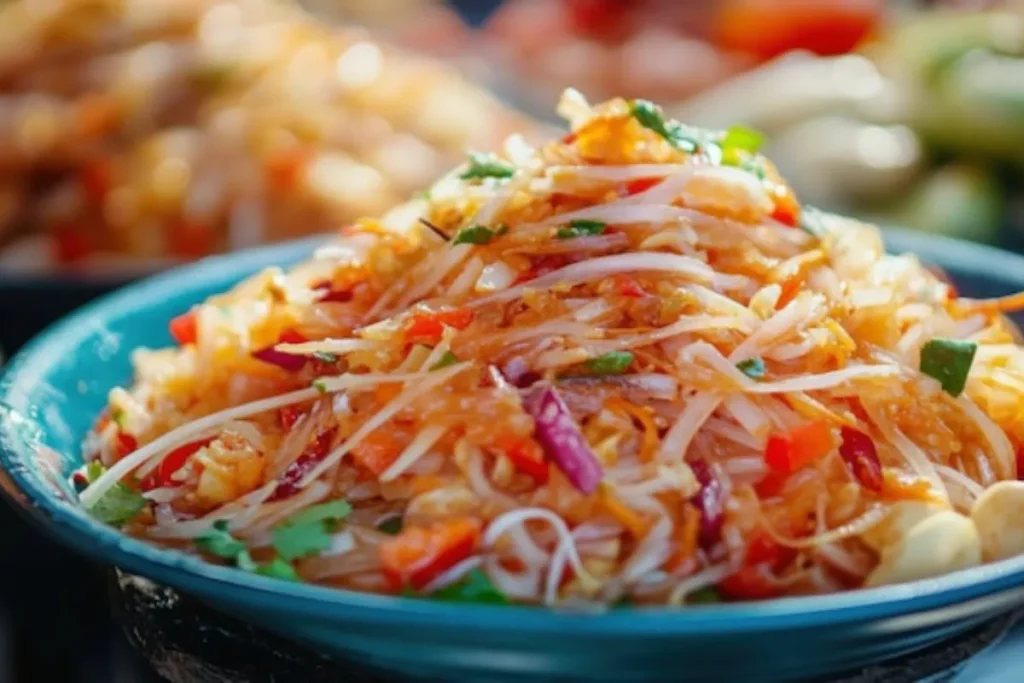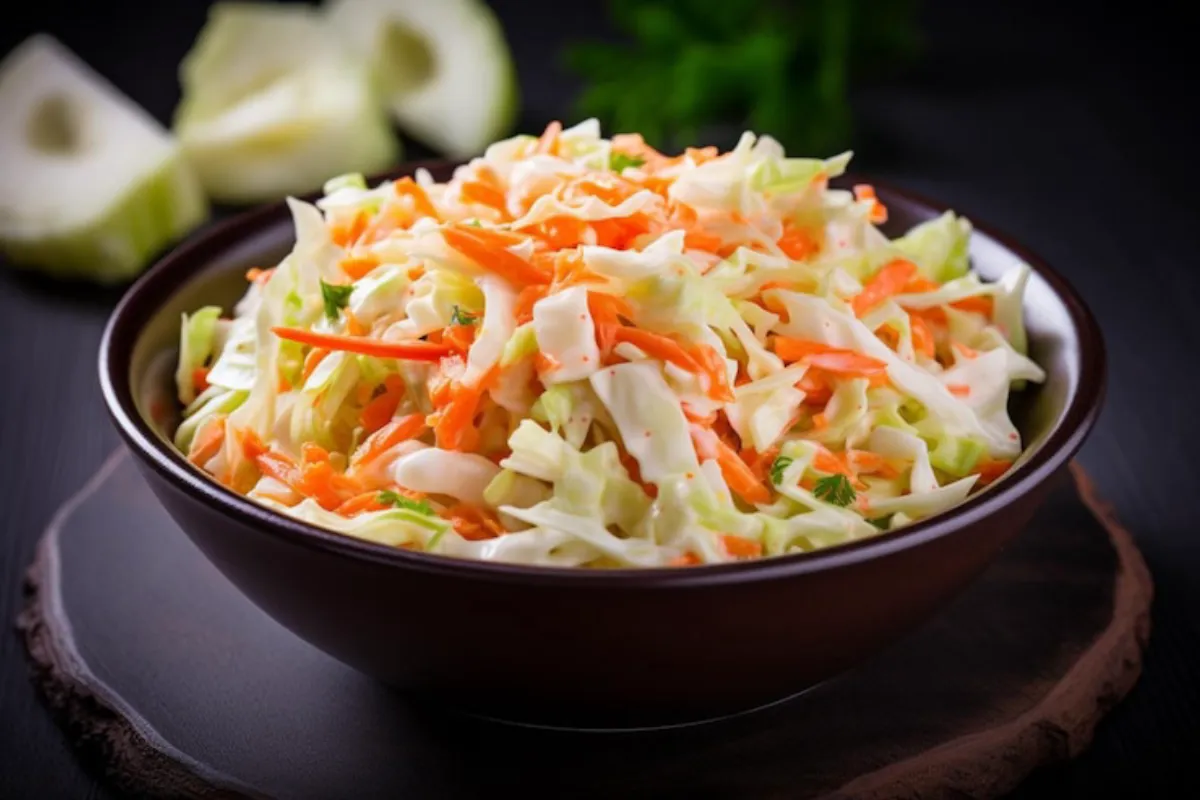If you’re a fan of bold flavors and love experimenting with different cuisines, then this Korean coleslaw recipe is perfect for you. It takes the classic coleslaw you know and transforms it into a spicy, tangy, and savory dish with a distinctly Korean twist. Whether you’re looking for a refreshing side dish to pair with your favorite Korean BBQ, or a flavorful topping for tacos or sandwiches, this Korean coleslaw will quickly become one of your go-to recipes.
In this blog post, we’ll walk you through every step of making this vibrant dish. You’ll also discover tips, variations, and serving suggestions that will help you make this recipe uniquely yours. So, let’s get started on this exciting journey into the world of Korean coleslaw.
What Makes Korean Coleslaw Unique?
When you think of coleslaw, you might picture a creamy cabbage salad often served at picnics or barbecues. However, Korean coleslaw breaks away from that mold. The flavors in this recipe are inspired by traditional Korean ingredients and seasonings like gochugaru (Korean red pepper flakes), sesame oil, and soy sauce. These ingredients bring a completely different dimension to coleslaw, turning it into a dish that’s spicy, tangy, savory, and slightly sweet all at once.
What sets Korean coleslaw apart is not only the flavor profile but also the textures. You’ll get the crunchiness of fresh vegetables paired with the smooth, rich dressing, making each bite an explosion of flavor and texture. The combination of ingredients ensures that it pairs well with everything from grilled meats to seafood, making it a versatile dish that can fit into many different meals.
Why You’ll Love This Recipe
There’s plenty to love about this Korean coleslaw recipe. First and foremost, it’s a simple dish that delivers big flavors. You don’t need a long list of hard-to-find ingredients or complex cooking techniques. Everything comes together in one bowl, making it a quick and easy recipe for both beginners and experienced cooks.
Additionally, this coleslaw is incredibly versatile. It’s a great side dish on its own, but it also works as a topping for tacos, sandwiches, or even burgers. The bright, bold flavors add a refreshing contrast to rich or spicy main dishes, and it complements many different types of cuisines beyond Korean fare.

Ingredients for Korean Coleslaw
To make this flavorful Korean coleslaw, you’ll need just a few key ingredients, many of which you might already have in your pantry. The fresh vegetables bring texture, while the Korean seasonings infuse the dish with bold, unique flavors.
Main Ingredients:
- 4 cups of shredded cabbage (green or Napa cabbage works best)
- 1 large carrot (julienned or grated)
- 1/2 red onion (thinly sliced)
- 2 green onions (chopped)
- 1 tablespoon toasted sesame seeds (for garnish)
Dressing Ingredients:
- 2 tablespoons soy sauce
- 1 tablespoon rice vinegar
- 1 tablespoon sesame oil
- 1 tablespoon gochugaru (Korean red pepper flakes)
- 1 tablespoon sugar (or honey for a sweeter option)
- 1 teaspoon minced garlic
- 1 teaspoon ginger (freshly grated or minced)
- Salt and pepper (to taste)
Optional Add-Ins:
- Cucumber slices (for extra crunch)
- Korean radish (thinly sliced)
- Fresh cilantro (for a hint of freshness)
These ingredients are simple but pack a punch of flavor. The base of cabbage, carrot, and onion gives you a nice variety of textures, while the dressing adds the signature Korean flavors you’ll love.
Step-by-Step Instructions for Korean Coleslaw
Now that you have all the ingredients ready, let’s dive into how to make this delicious Korean coleslaw. The steps are straightforward, and you’ll have this dish ready in no time.
Step 1: Prepare the Vegetables
Start by preparing the vegetables. Shred or chop the cabbage into thin strips, and julienne the carrot or grate it using a box grater. Thinly slice the red onion and chop the green onions. If you’re adding any optional vegetables like cucumber or Korean radish, slice them thinly as well.
Place all the prepared vegetables into a large mixing bowl. Toss them gently to combine the ingredients, ensuring that the cabbage, carrot, onion, and any other vegetables are evenly distributed.
Step 2: Make the Korean Dressing
In a small bowl, whisk together the soy sauce, rice vinegar, sesame oil, gochugaru, sugar (or honey), minced garlic, and freshly grated ginger. Whisk until all the ingredients are fully combined, and the sugar has dissolved into the dressing.
Taste the dressing and adjust the seasoning if necessary. If you want a spicier kick, add more gochugaru. For a slightly sweeter dressing, add more sugar or honey. The balance of spicy, sweet, and tangy flavors is key to making this coleslaw stand out.
Step 3: Toss the Vegetables with the Dressing
Pour the dressing over the prepared vegetables in the mixing bowl. Using tongs or clean hands, gently toss the vegetables to ensure that every piece is coated in the flavorful dressing. The cabbage and carrots will start to absorb the dressing, taking on that delicious Korean-inspired flavor.
Let the coleslaw sit for about 10-15 minutes before serving to allow the flavors to meld together. This also gives the vegetables a chance to slightly soften while still maintaining their crunch.
Step 4: Garnish and Serve
Once the Korean coleslaw has rested and the flavors have developed, it’s ready to serve! Transfer the coleslaw to a serving dish and garnish with toasted sesame seeds for added texture and flavor. You can also sprinkle chopped green onions or fresh cilantro on top for a fresh finishing touch.
Serve the Korean coleslaw alongside your favorite dishes, or use it as a topping for tacos, burgers, or grilled meats. The combination of crunch and bold flavors makes this coleslaw a versatile and delicious addition to any meal.
Tips for Making the Best Korean Coleslaw
To ensure your Korean coleslaw turns out perfectly every time, here are a few helpful tips:
Use Fresh Vegetables
The key to a great coleslaw is using fresh, crisp vegetables. Look for cabbage that is firm and heavy, with tightly packed leaves. The carrots should be bright and crunchy, while the onions should be crisp and flavorful. Fresh vegetables will provide the best texture and flavor for the coleslaw.
Adjust the Spice Level
The beauty of this recipe is that you can easily adjust the spice level to suit your taste. If you like your coleslaw extra spicy, feel free to add more gochugaru or even a touch of gochujang (Korean red chili paste). For a milder version, simply reduce the amount of gochugaru or omit it entirely.
Let the Coleslaw Sit
While you can serve the coleslaw immediately, allowing it to sit for 10-15 minutes helps the flavors develop and meld together. This resting time softens the vegetables slightly while still keeping their crunchy texture intact.
Customize with Add-Ins
Feel free to get creative with your Korean coleslaw by adding extra ingredients like cucumber, Korean radish, or even roasted peanuts for added texture. The beauty of coleslaw is its versatility, so don’t be afraid to experiment with different flavors and textures.
Variations on Korean Coleslaw
While the classic version of Korean coleslaw is delicious on its own, there are plenty of ways to customize and enhance this dish. Here are a few variations you can try:
Spicy Korean Coleslaw
If you love heat, amp up the spice factor by adding gochujang to the dressing. Gochujang is a thick, fermented chili paste that adds depth and heat to any dish. You can start with a teaspoon and adjust to taste. This will give the coleslaw a richer, spicier flavor that pairs beautifully with grilled meats or spicy dishes.
Creamy Korean Coleslaw
For a creamier version of Korean coleslaw, you can add a tablespoon or two of mayonnaise or Greek yogurt to the dressing. This will give the coleslaw a slightly richer, creamier texture while still maintaining the bold flavors of the Korean ingredients.
Vegan Korean Coleslaw
To make this dish vegan, simply swap out the honey in the dressing for maple syrup or agave nectar. All the other ingredients are plant-based, so it’s easy to adapt this recipe to fit a vegan diet.
Tangy Cucumber Korean Coleslaw
For an extra refreshing twist, add thinly sliced cucumber to the coleslaw. The cucumber adds a crisp, fresh element that pairs well with the bold, tangy flavors of the dressing. You can even use a spiralizer to create fun cucumber ribbons for added texture and visual appeal.
Serving Suggestions for Korean Coleslaw
Korean coleslaw is a versatile dish that pairs well with many different meals. Here are a few ideas for how to serve it:
As a Side Dish for Korean BBQ
This coleslaw is the perfect side dish for Korean BBQ, whether you’re grilling bulgogi (marinated beef), galbi (Korean short ribs), or spicy pork. The crisp, tangy coleslaw provides a refreshing contrast to the rich, savory flavors of the grilled meats.
Topping for Tacos or Sandwiches
Use Korean coleslaw as a topping for tacos, sandwiches, or sliders. The crunchy texture and bold flavors make it a great addition to pork tacos, fried chicken sandwiches, or even veggie burgers.
With Grilled Seafood
The bright, bold flavors of Korean coleslaw pair beautifully with grilled seafood like shrimp, salmon, or mackerel. The tanginess of the dressing complements the natural sweetness of the seafood, creating a well-balanced meal.
On Its Own as a Light Meal
If you’re in the mood for something light, you can enjoy Korean coleslaw on its own as a refreshing meal. Add some grilled tofu or tempeh on top for a protein boost, and you have a simple yet flavorful vegetarian dish.
FAQs About Korean Coleslaw
Can I make Korean coleslaw ahead of time?
Yes! You can prepare the coleslaw up to a day in advance. Simply keep the vegetables and dressing separate, and toss them together just before serving to maintain the crunch of the vegetables.
How long does Korean coleslaw last?
Korean coleslaw will keep in the refrigerator for about 2-3 days in an airtight container. However, keep in mind that the vegetables may lose some of their crunch over time as they sit in the dressing.
Can I use a different type of cabbage?
Yes, you can use green cabbage, Napa cabbage, or even purple cabbage for this recipe. Each type of cabbage will give the coleslaw a slightly different texture, but all will work well with the dressing.
What can I use instead of gochugaru?
If you don’t have gochugaru, you can substitute it with red pepper flakes or a pinch of cayenne pepper for heat. The flavor won’t be exactly the same, but it will still add a nice level of spice to the coleslaw.
Can I freeze Korean coleslaw?
Freezing coleslaw isn’t recommended, as the fresh vegetables will lose their crisp texture when thawed. It’s best to enjoy Korean coleslaw fresh for the best flavor and texture.
Conclusion
Korean coleslaw is a bold, flavorful twist on traditional coleslaw that brings together the best of Korean flavors and classic coleslaw ingredients. The combination of fresh, crunchy vegetables with a tangy, spicy dressing makes this dish perfect for a variety of meals, from Korean BBQ to tacos and more. Best of all, it’s quick and easy to prepare, so you can whip it up in no time for a simple yet delicious side dish.
Whether you’re a fan of Korean cuisine or just looking to try something new, this Korean coleslaw recipe is sure to become a favorite in your kitchen. With its bold flavors and versatile uses, you’ll find yourself reaching for this recipe again and again.
So, the next time you’re in need of a refreshing, flavorful side dish, give Korean coleslaw a try—you won’t be disappointed!
